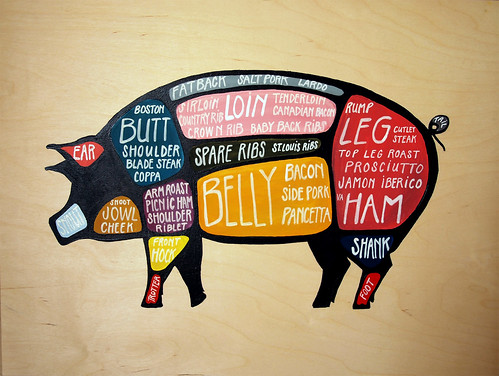FOOD CLUB - NOSE TO TAIL

It could be said that European civilization – and Chinese civilization too – has been formed on the pig. Easily domesticated, omnivorous household and village scavenger, clearer of scrub and undergrowth, devourer of forest acorns, yet content with a sty – and delightful when cooked or cured, from his snout to his tail.
Serves 10
2 Tbsp olive oil
175 g onions, finely chopped
1 kg rindless boned pork belly
175 g rindless back bacon
175 g lamb's or pig's liver, cut into small pieces
2 small cloves garlic, finely chopped
large handful parsley, finely chopped
½ Tbsp chopped rosemary
½ Tbsp chopped thyme
1 tsp salt
½ tsp freshly ground black pepper
Put the pork belly into a food processor and chop, using the pulse button, into a coarse but not too coarse mixture. Add to the onions in the bowl. Put the bacon and liver in the food processor and again, coarsely chop, then transfer to the bowl.
Add the garlic, chopped herbs, salt and pepper and mix everything together really well - the best way of distributing the ingredients evenly is with your hands.
Uncover the terrine and cook for a further 15 minutes, until it is lightly coloured on top. Remove the dish from the roasting tin and leave to cool, then weight down the terrine overnight in the fridge. The easiest way to do this is to cut out a piece of cardboard that will fit inside the rim of the dish, cover it with foil, then place it on top of the terrine and place a few weights or unopened cans on top.
To serve, remove the terrine from the dish in slices. Accompany with lots of crusty bread, beetroot chutney and some cornichons (gherkins)
This is a typical Greek winter meze, which would have commonly been served to the men after they come home from a long day in the fields collecting main crop potatoes.
2 tbsp olive oil
50g butter
1 kg belly pork, cut into 1 cm cubes
150ml red wine
700g leeks (slice then finely using the white part only)
Sea salt and freshly ground black pepper
Add the leeks and adjust the seasoning. Cover the pan, turn the heat down and cook until the leeks start falling apart and taste very sweet. The secret is to cook the mixture until the leeks have melted down to a sauce, which will take about 45 minutes.
Check the seasoning again (be generous with the black pepper) and serve dish immediately.
This method is fantastic – the milk tenderise the meat, helps retain moisture and absorbs all the rich juices from the pork!
1 pork shoulder, weighing about 1.5kg
2 litres milk
3 garlic cloves
1 fresh thyme sprig
1 fresh rosemary sprig
2 bay leaves
4 strips of lemon zest (I use a peeler)
Few grinds of black pepper
Sprinkle of sea salt flakes
Preheat the oven to 180C
Put the pork in a large casserole, pour in the milk and add the garlic, thyme, rosemary and bay leaves.
· The milk ‘jam’ stage occurs when the milk has evaporated into an almost curdled state with a thick jus (gravy) sitting beneath.
It is hard to resist juicy roast pork with crackling and to be honest there really is very little to do when you have such fantastic quality pork. The few herbs are only to enhance the pork not to take away the natural flavour!
1 tsp fennel seeds
Generous pinch of chilli flakes
Flaky sea salt and freshly ground black pepper
2 Tbsp oil
2-3 bay leaves
1 boned shoulder of pork (about 2.5kg) – score the skin about 1cm apart (or get the butcher to do it)
Heat the oven to 220C.
Rub the paste all over the flesh and skin of the pork.
Lay the bay leaves in a roasting tray (use one that's not too big, so the juices don't burn), put the pork on top skin side-up, and roast for 30 minutes, until the skin has started to puff up and begun to look like crackling. Turn the heat to 160C, and roast for a further 2 ½ hours until the meat is very tender and the juices run clear.
Mustard or leek mash
Potatoes roasted with fennel and lemon
Mustard and potato gratin
Fennel slow braised with ginger
Fennel salad
Wilted spinach, locally grown carrots, cabbage or Brussels sprouts
Roasted apples or quince, chutney and jelly
Mustard – all types